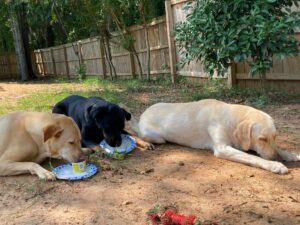DEI in meetings BIG and small
By: Kristyn McCauley, CAE, CMP
Over the past year I have served on the Florida Society of Association Executive’s DEI (Diversity, Equity, and Inclusion) Committee, and part of my desire for serving on this committee came from wanting to be part of these conversations that I think are really important to have when you work in the AMC model for multiple, diverse clients with diverse memberships. Selfishly, I wanted to see what I could glean from these conversations that could positively impact how I interact with the groups I work with.
As a meeting planner that works with three of our PIAM clients I have been specifically interested in how DEI efforts can and should impact how we design and run our meetings. As association executives we find ourselves in several meetings a week, both in-person and virtually. These are a mix of internal staff meetings, board and committee meetings, as well webinars and larger in-person conferences. Over the past couple of years as meeting virtually has grown in popularity we have had even more opportunities to interact with our organizations’ leadership and members.
How do DEI efforts affect all these meetings? Well, there are lots of things to consider as we work towards making our association events welcoming to all our members, vendors, and prospects. Many of these considerations can also apply to our board and internal staff meetings as well. For our association events, work places, and boards not only do we strive for diverse representation – diversity in career status and stage, age, gender, abilities, strengths, race, sexual orientation, etc. but we want all those diverse people to actually feel like a welcomed part of our community – equitable to one another and included in the event activities and discussions. As I have been researching this topic I’ve found that luckily for us there are lots of resources out there to reference as we work towards this goal.
Here are a few tips I’ve learned from a small handful of these resources:
For larger meetings & conferences:
- Create a DEIA pledge and code of conduct for attendees to agree to during registration. These pledges include things like agreeing to treat everyone with respect and using inclusive and intentional language. 1 There are several resources available for language for this pledge including https://deipace.com/.
- Work with your sponsors and other partners to provide scholarships for increased access to your events.1 These scholarships can serve as an invaluable resource to those new to the industry/profession and even those who are more tenured in their service but either don’t have the financial support of their employer and/or the personal means to attend your event. Career fairs, resume review sessions, and industry 101 courses can also help those new to the profession feel welcome and included.
- Build an event website that is ADA and WCAG compliant to ensure accessibility and equal access for people of all abilities. This could include structuring your content in a logical, meaningful way, including thoughtfully written alt text on all images, and choosing fonts, font sizes, and font colors that meet accessibility guidelines.2
- Ensure promotion and invitations are distributed in an inclusive manner. Share information in a way that multiple audiences can view (such as on social media).3 Especially for more diverse memberships, we will likely have members that like to receive information from our association in different formats. Consider print, email, social media – all the different ways to reach all segments of our memberships and potential attendees.
- For Q&As, try starting with a woman, member of a minority group, or early-career professional. This helps ensure underrepresented voices are heard and may also provide the safety and confidence to those who might not otherwise share their thoughts.3 Be mindful of those that tend to dominate the discussion and be sure your facilitator is comfortable getting others to speak up.
- Your speakers’ lineup should be as diverse as the audience your event is reaching. In practice, ensure an adequate balance in terms of gender, race, ethnicity, ability, sexual orientation, religion, age, and other characteristics. Alongside making your audience feel included and welcomed, a diverse lineup will contribute to richer conversations, sessions, and events.4
For board & internal staff meetings:
- Establish clear group norms and agreements at the start of the meeting – and stick to them. When inclusive meeting conduct is codified, it puts offenders on notice and makes participants aware of their rights and responsibilities.5 This could include getting the attendees to sign a DEIA pledge as referenced above so that all understand and agree to the expectations of creating a welcoming space for all.
- If a big question arises, consider taking a few minutes for the group to put their ideas on paper before having everyone share. This gives less vocal participants time to gather their thoughts and ensures everyone’s voice will be heard.6
- Be mindful of conformity bias, which occurs when people feel pressured to agree with everyone else in the room.6 It may help to call on the less vocal participant first to allow them the opportunity to share their thoughts before a more vocal participant chimes in and all others simply agree. This could be especially true in situations where there are different levels of seniority or tenure and the newer members may automatically differ to someone who has been serving on the board or within the organization longer.
These are just a few actionable ideas to include in the planning and execution of future meetings and events to help foster the diverse, equitable, and inclusive spaces our organizations strive to create.
For more information on how this timely topic directly impacts the business meeting industry, check out the Events Industry Council Equity Task Force’s 2022 Equity Benchmarking Study published in October 2022.
- https://www.asaecenter.org/resources/articles/an_plus/2022/07-july/ten-things-meeting-pros-should-start-doing-now-to-improve-diversity-equity-inclusion-and-accessibility/?utm_medium=email&utm_source=rasa_io&utm_campaign=newsletter
- https://www.bizzabo.com/blog/diversity-and-inclusion-events-industry/
- https://www.idsa.org/DEItoolkit
- https://inevent.com/blog/others/diversity-inclusion-in-events-6-strategies-to-improve-event-planning.html
- https://www.remotedei.org/strategies/meeting-design
- https://www.developmentguild.com/dei/how-to-lead-inclusive-meetings/
Kristyn McCauley, CAE, CMP has worked in association management since 2014. She earned her CMP in 2018 and CAE in 2021. Kristyn is a graduate of FSU and lives in Tallahassee with her husband and their three children.





